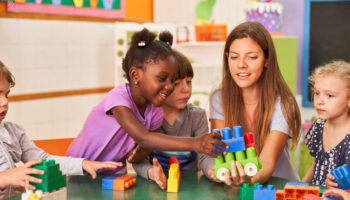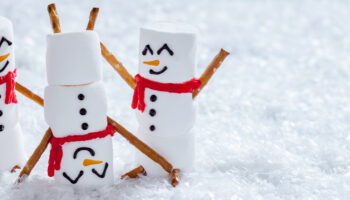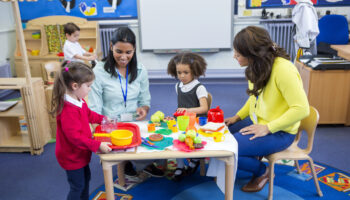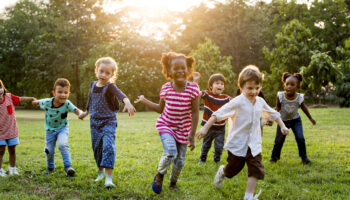Erin DelRegno
I don’t know about you, but much of my time as a child was spent playing outdoors. For example, I climbed trees, jumped in rain puddles, rode my bike, and played hide-and-seek. I stayed outside until dinner time, but that isn’t something that happens anymore. So much natural learning takes place outdoors. Wouldn’t you want to create an outdoor environment for the children in your care that provides a wide variety of learning experiences to them? Don’t you want to provide them with choices so they will be interested and challenged the whole time they are outside?
What if I told you that you can bring the interest centers you have in your classroom outdoors. You can make so much using materials you already have in your home or with inexpensive materials you can buy at local stores. There are so many things you can do to create an outdoor space that helps children enjoy nature, explore, learn, and get the most out of their time outdoors. Following are some examples of ideas you can use when creating your own outdoor areas:
Gross Motor
- Tree stumps or tree cookies – These can be used for balance and you can have them at the same or different heights to create a pathway. You can even space them farther apart for older children.
- Large logs provide opportunities to climb on or use as a balance beam.
- Large rocks – Children can sit on, crawl on, or use as stepping stones, etc.
- Tire tunnels can be used to climb and crawl on.
* Try contacting your local landscape supplier – Maybe you can get these items for free or for a discounted price.
* Safety reminders to consider:
- Make sure to secure these materials to the ground for safety.
- Use impact absorbing materials under equipment to cushion falls and prevent serious injuries (mulch, rubber surfacing, etc.).
- Make sure all equipment has appropriate fall zones around and between equipment. These are the areas under and around sliding/climbing equipment where impact absorbing material is required.
- For additional information consult the S. Consumer Product Safety Commission (CPSC), Public Playground Safety Handbook.
Fine Motor
- Tie ribbons to the fence – Children can weave them through the fence.
- Paint the side of a shed or wall with chalkboard paint or magnetic paint.
- Hang cookie trays on the fence for use with magnets.
- Hang up a low clothesline – Beads can be slid on it to make an abacus.
Science/Math
- Tires can be filled with soil for planting flowers, grass, or fruits/vegetables.
- Hang bird houses/feeders to attract birds for children to view.
- Use a refill jug for your bubble solution – Children can fill up their cup/tray when they run out.
- Provide homemade bubble wands (pipe cleaners, plastic hangers, soda bottles, etc.).
- Make giant bubbles using bubble solution, a large tub, and hula hoop.
- Provide an investigation bag or basket with magnifying glasses, butterfly nets, bug viewer jars, magnet wands, mirrors, color paddles, etc.
- Create a ball maze with rain gutter pieces or PVC pipe (can be attached to a fence or separate board).
- Create a scale with a hanger and two small buckets/pails.
Art
- Make an easel available or hang an easel on the fence.
- Use clothes pins to hang paper on chain link fence.
- Large rocks can be used as tables for drawing.
- Slate pieces can be hung up and painted on with water and paint brushes.
- Use different elements as paint brushes (feathers, leaves, pine cones, etc.).
- Let children collect natural elements (sticks, shells, flowers, etc.) and glue a collage on paper.
Dramatic Play & Block Areas
- You don’t need a full kitchen – Provide children with props and they will come up with the rest (pots and pans, food, dolls, etc.).
- If you want a kitchen, create one with large cardboard boxes.
- Tree stumps can be used as seats around a table.
- Hang a low clothesline – Clothes pins can be used to hang up clothes.
- Provide children with loose materials they can build with (small wood pieces, rocks, wood planks, sticks, etc.).
- Provide milk crates for stacking.
Cozy Book Area
- A tree provides some shade for reading, if you have this available.
- Hang up sheer fabric, scarves, or streamers – They will create some privacy and will blow in the wind, as well.
- Provide a bookbag of materials (variety of books, a blanket, stuffed animals, etc.).
Music
- Create wind chimes with silverware.
- Create drums with a garbage can, large barrels, buckets, tins, etc.
- Wooden spoons can be used to tap on garbage can lids, different size pots and pans, tin cans, etc.
- A wire shelf can be used to hang these instruments on, and it can be scraped with the wooden spoon for a different sound.
- Provide plastic bottle shakers filled with small pebbles.
- Hang a bird feeder with food to attract birds for natural music.
Sand/Water
- Let children use natural elements with the sand, and don’t be afraid to add water.
- Use sticks to write/draw in the sand.
- Create a water maze with plastic bottles, pop tubes, gutters, or PVC pipes attached to a fence or separate board.
- Provide a rain water bin to collect and measure rain water.
Let the children in your care get some fresh air and more exercise. Fill their time with a variety of experiences and do whatever you can to give them the same types of outdoor play memories you have from childhood. Below are links for two articles and a resource blog that discuss the importance of outdoor play and provide even more outdoor play ideas:
Maximizing Outdoor Play: Moving Interest Centers Outdoors




